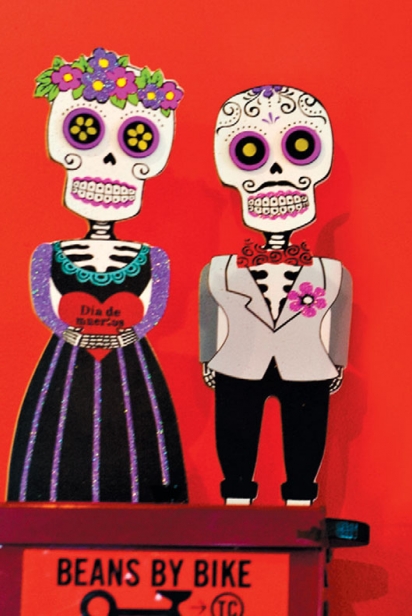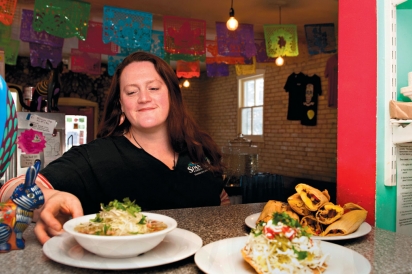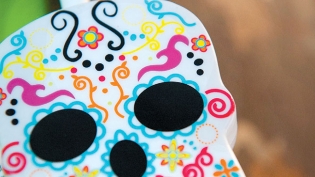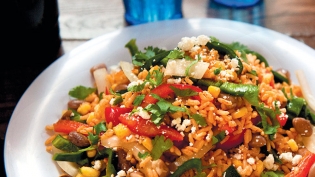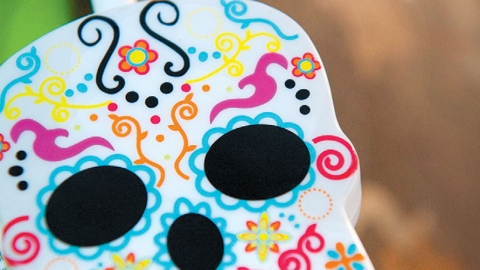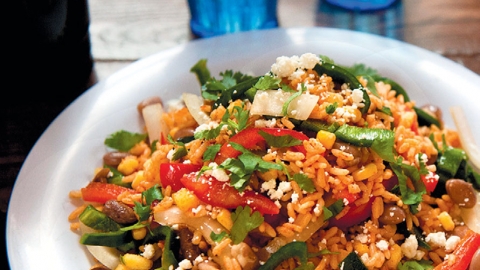Learning Spanglish
Anna and Vicente Serrano’s story reads like the script of a compelling feature film:
Vicente, a poor orphaned boy being raised by his morally strong but physically handicapped grandmother in a rural village high up in Mexico’s rugged and dangerous Sierra Madre del Sur mountain range, strikes out on his own at age 12 and lives from hand to mouth, somehow managing to survive his circumstances.
Anna, a Traverse City native from a close, nurturing family with ties to what is now the Village at Grand Traverse Commons dating back to the early 1900s, earns a college degree in science and foresees a career in environmental restoration.
How and where did these two people, from vastly different worlds, meet and fall in love? Anna was Vicente’s boss when both of them worked in the kitchen of a luxury health spa in Northern California in 2000.
Fast forward to June 2013. Anna and Vicente, by now married for over ten years and living in Anna’s hometown, open their new restaurant, Spanglish, in Building 69 on the grounds of the former Traverse City State Hospital, now the Commons. The concept: fresh, healthy, flavorful, made-from-scratch food that blends the ingredients, cooking techniques and cultures of their native countries. And just like the tamales that they had been selling by the hundreds at the Saturday market in the Mercato at the Commons for the previous 18 months, the new venture is an instant hit.
But lest this sound like a film with very little plot development, read on…
There are the connections, beginning with grandparents. Anna’s great-grandmother graduated from the nursing school at the old State Hospital at the beginning of the 20th century. Her maternal grandfather was a doctor at the hospital, and her paternal grandmother a registered nurse.
“I have very deep roots here at the Commons,” she says. “And very strong food memories from growing up: There were gardens and canning sessions for jam and corn, and I learned how to cook just about anything from my grandma and my mom at a very young age. I grew up with that really close connection to the land and to food.”
After high school Anna earned an associate degree in science from Northwestern Michigan College. “I was studying environmental science and botany and, during the school year, I worked the early morning shift at Bay Bread. In the summer, I worked in environmental restoration—that was one of my passions—but in the wintertime, I worked in restaurant kitchens, because food was my other passion.”
Vicente’s upbringing could not have been more unlike Anna’s. His mother died when he was just 7 years old, and his brother was 5. His grandmother, Patricia, took them to live with her at her coffee farm, telling them that she would do everything she could to protect them. And protection was necessary. The region he grew up in was rife with drug lords and kidnappers, and many young men chose the wrong path.
“I tell my kids, ‘Be honest—it will keep you out of trouble,’” says Vicente. “That’s what my grandma taught me. I always think of her and wish she had survived so she could see what I am doing now.”
Anna reassures him: “She knows, and she is proud of you.”
LIFE LESSONS IN SURVIVAL
Anna says Patricia (which is her own mother’s name—another connection) helped Vicente through some of the worst situations one could imagine.
“She did a good job with the boys. She gave them a lot of responsibility at a very early age. She toughened them up, because she knew they would need it, but she didn’t take away that sensitivity for life and for each other and for themselves, which I think is a hard balance to strike. Because of her, Vicente is definitely a survivor. He has moral integrity and he has a really specific skill set, including being self-sufficient.”
Vicente adds, matter-of-factly, “I’ve been cooking most of my life, even before I was with my grandma. The food was there—you just had to harvest it or catch it or forage it first. I did rough farm labor most of my life, and I didn’t complain about it. But I felt if I had the opportunity to learn to do something else that I really liked, I would try to do it.”
That opportunity came when he moved to Northern California, where he had a cousin, in 1999. There he found a job working as a dishwasher at the health spa where he would soon meet his future wife.
Vicente had worked at the spa for about eight months before Anna landed there. “I wanted to continue my studies, so had I applied to two universities, but neither worked out. It made me think that maybe I was meant to be doing something else. So I decided to go to California, where my aunt and sister lived in the San Francisco Bay area,” she says.
“As it turned out, one of my aunt’s friends worked the front desk at that health spa, and I needed a job, and they were hiring. At the interview, they asked, ‘What can you do in the kitchen?’ And I said, ‘Whatever needs to be done.’ I did all the cooking, and Vicente was my prep person and salad person. And he was good at it. I didn’t speak Spanish at the time, and he didn’t speak any English, but we worked so well together. We were such a good team. The Spanish I know, I learned from him, and the English he knows, he learned from me.”
Moving to Traverse City from California just kind of evolved, they both say—it was, like so many of their individual and mutual decisions—instinctive.
“We didn’t talk about opening our own restaurant in the beginning, says Anna.” I went back to Bay Bread as a manager, and Vicente worked at a Christmas tree farm for a couple of seasons. It was a good change of pace for both of us for a while—we needed a little something different.” But in time, they both realized that they missed working together. It was Vicente who finally verbalized it, though, saying, “We have to open our own business.”
They had both worked in enough restaurants to know the failure rate and how much work would be demanded of them. “We also knew that we wouldn’t go into anything half-heartedly,” says Anna. “If we were going to do it, we were going to give it our all and do it right.”
They discussed various potential sites within the Commons with the owners of the Minervini Group, whose company has been responsible for the “resurrection” of the historic buildings there, and it turned out that the lease was coming to an end on the property that then housed the Underground Cheesecake Company.
“I came in with my dad one day after that to check it out and almost immediately said, ‘Uh-oh, this is what I was afraid of….’ I absolutely loved the space and the location. I could see us being here. I could see the restaurant. I could see all of the things that we could do to make it work, and why it would work. And that was both amazing and terrifying. But this was where I wanted to be.”
DOING MORE—AND BETTER—WITH LESS
Thanks to Anna’s environmental science background, and Vicente’s poverty growing up, they were both very tuned in to the sustainability aspect of planning and opening a restaurant.
“The philosophy of ‘reduce, reuse, recycle’ is ingrained in us,” says Anna. “Even if we had had enough money to do everything new, we wouldn’t have spent it. The equipment, the furniture, the renovation—everything we had to buy, fix or organize to get up and running—followed that model. We are very thrifty and environmentally conscious with our day-to-day operation, too. We compost everything, and at the end of the day, for as many people as we serve food to, we have just one bag of garbage.”
People often think of Mexican food as heavy, caloric and smothered in yellow cheese, but that’s not the kind of food Spanglish serves up. “You can see the health spa influence on our menu,” says Anna, “because every item is deconstructed to accommodate almost any food issue. There are even cardiologists at Munson who recommend us to their patients, because they know we don’t over-salt things, the beans aren’t made with pork fat, and the rice is only cooked in water, sea salt, chilies and garlic.
“Our food is very flavorful, but we use healthier ways to give it that flavor. I know what goes into everything on the menu, if someone asks me. The tamales are all gluten-free, and you can get vegan beans and rice, tacos, tamales and tostadas if you want. We make it really easy for customers to mix and match and get what they want.”
Most of the ingredients used at Spanglish are either Michigan-sourced or locally sourced through Cherry Capital Foods. In season, Loma Farms provides produce. Michigan pinto beans are sourced through Bodega de San Marcos, a Mexican foods wholesaler in Grand Rapids that is also a good source for avocados and tomatillos. Most of their Mexican ingredients come from the TC Latino grocery.
“Today, I still see a lot of those same faces from the farmers’ market—those people followed us here,” says Anna. She is also pleased that a lot of their customers are business people, restaurant workers and residents from right within the Village. “We have a good relationship with our neighbors. We all try to support each other.”
THE SPANGLISH EXPERIENCE
On a cold and crisp winter morning, Spanglish beckons with warmth and whimsy: Salsa red and avocado green walls behind the counter are hung with meticulously hand-lettered chalkboard menus and some very non-scary Day of the Dead skeletons; comfortably upholstered former church pews serve as banquette seating for tables; rows of multi-colored papel picado (cut paper) flags are strung across the ceiling; and a large metal butterfly sculpture hangs above the entrance door. Add to that the tantalizing aromas from the dishes coming out of the kitchen, and you have a pretty irresistible combination.
“We wanted it to be a place where anybody could feel comfortable eating,” says Anna. “It’s all very homey, very rustic, very casual—it is, in a word, ‘us.’”
Vicente and Anna’s passion for what they do infuses the character of Spanglish as deeply as the carefully chosen ingredients lend their food its unique character.
So how is it having a family and a restaurant? “Of course, it’s hard sometimes working together every day,” says Vicente. “But we make our relationship a priority,” Anna is quick to add. “We try to leave the restaurant behind when we go home at night.”
Cooking at home is another priority. Despite the demands of their business, they cook for their children (Eva, 11, and Octavio, 7) every day, with very few exceptions. “People often say to me, ‘How do you do it? It takes too much time and energy.’ And I say, ‘Can you think of a better way to spend your time and energy than on your family?’ Our kids enjoy cooking, too. Every week we let them pick something that they want to make—and then we teach them how to do it.”
Producing a picture of their son making homemade noodles, Anna says, “We were teaching him how to make chicken noodle soup.” For her, it seems like the most natural thing in the world for a 7- year-old to be making fresh noodles for a soup.
The circumstances were a bit different for Vicente when he was 7. “My grandma would tell me and my brother, ‘If you guys wanna eat chicken today, you’ve gotta go out and catch and kill one!’ And we spent hours in the woods chasing that chicken.”
And then there was the food-related incident that Anna says her kids will never let her forget: She was making their breakfast one morning, and when it was ready, they weren’t in the kitchen yet. “I had the finished plates in my hand, turned around, tossed them onto the table, and yelled, ‘Order up!’ without even thinking about it.”
So maybe it’s not always easy to leave the restaurant behind.
IF YOU GO:
Spanglish
1333 Yellow Dr., Traverse City
231-943-1453 • SpanglishTC.com
Skeletons and Skulls
So what’s with the whimsical skeletons and skulls that appear on business cards and menus, on T-shirts and as decorations on the walls at Spanglish? Anna Serrano explains that they are an inherent part of Mexican culture—symbols of the Day of the Dead. Despite its rather somber name, this annual observance each November 1–2 is actually a colorful, joyful, music-filled celebration honoring ancestors who have passed away. The symbols, which Anna calls “bold, striking and beautiful,” echo that celebratory mood. To honor the memory of a departed loved one, Mexicans build a shrine to that person at their grave and adorn it with photographs and treasured objects that belonged to them. There is also a strong food element: Family members make the person’s favorite foods, and pour them their favorite drink, and put those on the shrine as well.
“Just think of the power that has for future generations who never met those people,” says Anna. “They can feel a real connection and closeness.” For Vicente Serrano, who lost his mother at such an early age, and whose grandmother was a very important part of his life, the celebration continues every day at Spanglish.





